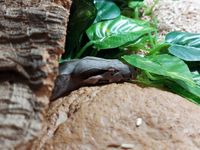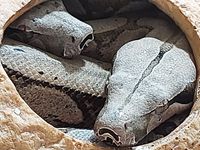Pure locality Boas/Pure Boas
Purity is not so easy as it seems. This comes from the history of keeping and breeding snakes. 50 years ago there was not a situation like it's today with youtube videos, blogs, facebook-communitys, books or experts. In these day there was almost nothing known about this animals and imports are very rare and even then nobody knows the location of catching them. Breeding Boas was an art, there was nothing known about subspecies. Later in the 1980's and 1990's the first books appear and the knowlege had grown a lot, but the most countries in south- and mittle America regulated exports very strict, so it was more difficult to get Boas were the locality was total clear. This wild caught Boas often were difficult to breed and it's a thing of years. Thats why some breeders mixed constrictor constrictors with imperators (there were much more easy to breed), just a few professional breeders had the patience, thats nessesary. Tody it's very difficult to find pure blood Boas and Pythons, i think more then 99% of all snakes in human hand are not pure.
Pure means that this snakes will be breed in lines of there exact locality (becaurse of the rare import-situation it is nessesary to breed them in line with related snakes). In europe we think this is the best way to conserve purity and keep the lines perfectly clear. So we don't cross lines, becaurse it is not clear that they are from the same localitys (catching snakes with geographic coordinates is not usual or possible often). So even if you don't know the exact locality, the snakes are indeed pure (as pure as possible). The most interesting localitys are from countries who forbid any export, so it is not possilbe so get wild caughts from this localitys.
Inbreeding is not a problem as we kow them from mamels and that seems to be a thing of the special genetics of reptiles. Parthenogenesis is known from a lot of reptiles and even in nature there are some populations with extremly small habitats like the hog island boa (Cayo de los Cochinos in Honduras). The island is less then 0.77mi² (2 km²) , that means a very small habitat, so inbreeding on the island is totaly usual, without any sign of extinction or degeneration. In europe we breed some localitys for decates this way without any problems.
The sience regognize the species "Boa Constrictor" and 11 to 10 supspecies, like "Boa constrictor constrictor" and "Boa constrictor imperator" (note there is NO "Boa imperator", this is scientifically irrelevant). The professional Boa keepers and breeders divide additionally the localitys, like Suriname. So this give the name "Boa constrictor constrictor Suriname". A responsible breeder would NEVER cross localitys or subspecies and in europe the professional breeders even respect the lines!

